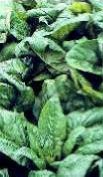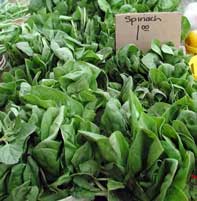Spinacia oleracea
Spinach, Espinaca
Temperate


Introduction
Spinach is an annual plant that was first cultivated in Persia over 2000 years ago. Its tender and nutritious leaves, either raw or cooked, were quickly recognized as a worthy addition to the human diet. Spinach spread north to Europe, east to India, and west to the New World, but it never really moved south to the tropics. High temperatures and increasing day length send a strong message to the spinach plant that its time to produce seed. When the seed making begins the quality of the greens declines sharply. Because of this, spinach has never really thrived in the tropics, except at cooler high elevations.
Spinach is so well accepted as a food that it has become the benchmark against which all dark green leafy vegetables are judged. While other greens and potherbs have been casually tossed into peasant stews, spinach has been a mainstay in gourmet restaurants and fancy markets. The popularity of spinach can be witnessed in the number of tropical plants that have been offered up as spinach substitutes. These include Malabar spinach (Basella alba), New Zealand spinach (Tetragonia expansa), water spinach (Ipomoea aquatica), and Chinese or African spinach (Amaranthus gangeticus). Affection for this plant soared to a high point with the obsessive spinach eating of Popeye the Sailor, perhaps the only mythological super-hero in any culture to derive his powers entirely from a dark green leafy vegetable.
Pros
- The flavor of spinach is almost universally appreciated.
- Is tender enough to be eaten raw in salads
- Can tolerate light freezes if acclimatized
- Commercially marketed frozen and canned
- Usually not bothered excessively by insects because it is grown in cool weather when insect activity is still minimal
- Along with collards, spinach had the highest levels of the carotenoids lutein and zeaxanthin, and were the most strongly associated with a reduction in age-related macular degeneration (AMD) risk. About 13 million Americans age 40 and older have this disease, which gradually destroys the sharp, central vision needed for seeing objects clearly and for common daily activities such as reading and driving. It is more common than glaucoma and cataracts combined.
Cons
- High levels of nitrates, especially when grown with high levels of soluble nitrogen fertilizer or at low temperatures or low light intensity
- High levels of oxalates, especially when grown at low temperatures
- Tends to bolt, or go to seed prematurely, under heat or water stress
- Spinach with curly leaves tends to have sand or grit attached that requires careful cleaning.
- Sensitive to waterlogging
- Difficult to keep young shallow rooted plants weeded, especially varieties with prostrate growing habit
Notes
- There are two basic types of spinach; savoy or crinkly leafed, and smooth leafed. The smooth leaf variety is normally grown for freezing and canning. It grows faster, yields more, is easier to clean and has lower levels of nitrates in the leaf than the savoy type spinach. The savoy is favored for home garden and fresh market use. It looks better, tastes better, keeps better, and has less oxalic acid than the smooth leafed type.
- Prefers soil with pH of 6.0 – 7.0
- Prefers well drained soil with high organic matter content
- Seed will germinate in very cold soil, but it does so very slowly with increased risk of fungal problems. Best germination temperature is 20° C (68° F).
- The protein in spinach leaves is rich in the amino acid methionine, a sulfur bearing amino acid deficient in most vegetable proteins.
Seeds
- Seeds for common varieties are almost universally available. Seeds for less common varieties can be obtained from good mail order seed houses.
Related Plants with Edible Leaves
Beta vulgaris ssp maritima (sea beet); B. vulgaris cicla group (Swiss chard); B. vulgaris crassa group (table beet, sugar beet); B. vulgaris var. orientalis (spinach beet, palak); Chenopodium album (lambsquarters); C. quinoa (quinoa); C. murale (Australian spinach); C. bonus-henricus (good King Henry); Atriplex hortensis (orach); A. halimus (sea orach); A. canescens (fourwing saltbush)